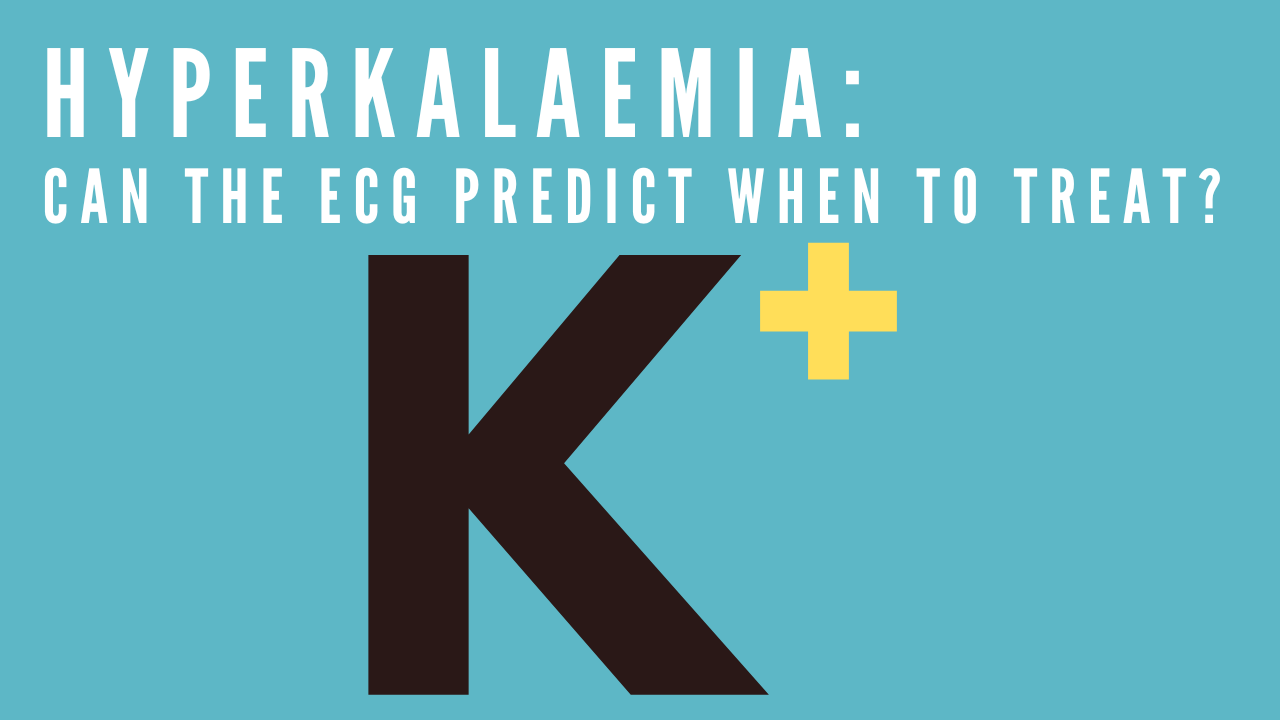A 65 yo patient with a history of hypertension and mild renal impairment, presents to your rural emergency department with some lightheadedness and shortness of breath.
His examination is normal. Bloods are sent for FBC and EUC and a troponin and an ECG is done. Does the ECG show changes consistent with hyperkalaemia?

(1)
In fact, this is a bit of a trick question, made to highlight a point.
The blood results on this patient come back and show Na 144 mmol/L, K 9.2 mmol/L. The creatinine is high. This ECG above is normal, without the expected ECG abnormalities of hyperkalaemia.
In experimental models there is an orderly progression of ECG changes, with increasing potassium. This does not always occur in clinical practice. There are multiple case reports of high potassium levels with no or minor changes in the ECG.
Studies have found that only about 50% of patients with a potassium greater than 6.8 mmol/L had ECG changes (2).
A Normal ECG Does Not Exclude Hyperkalaemia.
What are the ECG changes that we normally expect?

(Adapted from Szerlip (1))
ECG changes can predict adverse outcomes
A normal ECG in hyperkalaemia may be associated with a lower risk of adverse events. Isolated T wave abnormalities are at lower risk of adverse events, however conduction abnormalities may be associated with a higher risk of adverse events.
It appears that an abnormal ECG associated with hyperkalaemia is also associated with adverse outcomes(1) such as:
- symptomatic bradycardia
- ventricular arrhythmias
- cardiac arrest
- death
Should all Hyperkalaemic Patients receive Calcium?
The risks of giving calcium are small and mostly related to extravasation and no studies appear to have been done comparing calcium gluconate and calcium chloride.
Calcium gluconate at 10mL or 10% (contains 2.2mmol of Ca2+) compared with 10mL of 10% calcium chloride, (contains 7mmol of Ca2+). If the patient does not have haemodynamic instability, it is reasonable to use calcium gluconate and infuse over 5 minutes given too rapidly in the stable patient calcium can cause bradycardia and can affect blood pressure. In arrest, it is given as a push dose.
Who should we give calcium to?
There is no real consensus at present. A guide may be related to the stability of the patient and the presence of ECG changes.
- Patients with mild hyperkalaemia (<6.0-6.5 mmol/L) and no ECG changes, should probably not receive calcium (3, 4). There is some consensus here.
- There is no real consensus however, about patients with hyperkalaemia (>6.0-6.5 mmol/L) with no ECG changes or with isolated peaked T waves (5)
Irrespective of whether we give calcium or not, we should take other measures to lower the potassium including:
- 10U actrapid, 50mL of 50% glucose
- reduces K+ by up to 1mmol/L/hr
- NaHCO3 infusion 8.4% contains 1mmol/ml
- 1mmol/kg IV or 100mL of 8.4% over 10 minutes
- Use in metabolic acidosis, as it decreases the concentration of H+ and shifts K+ into cells.
- Beware not to give with calcium can cause precipitation
- Salbutamol nebulisers
- 0.5mg IV or 20mg neb
- Stimulates of Na+/K+ ATPase with subsequent increase in intracellular K+
Should we give Sodium Polystyrene Sulfonate?
These potassium-bindings resins, do not rapidly decrease the potassium levels, but lower them over several hours or days. There is little evidence to show that they are appropriate in the emergency setting(6). Use of these resins has also been associated with gastrointestinal adverse events including ulcers, colonic necrosis and perforation (7).
References
- Szerlip H, et al. Profound Hyperkalaemia without electrocardiographic manifestations. American Journal of Kidney Diseases, Vol VII, No 6 (June), 1986: pp 461-465
- Freeman K, et al. Effects of presentation and electrocardiogram on time to treatment of hyperkalemia. Acad Emerg Med. 2008;15:239–49.
- Alfonzo A, Soar J, MacTier R, et al. Clinical practice guidelines: treatment of acute hyperkalaemia in adults. UK Renal Assoc. 2014;147:59–77.
- Truhlář A, Deakin CD, Soar J, et al. European resuscitation council guidelines for resuscitation 2015: Section 4. Cardiac arrest in special circumstances. Resuscitation. 2015;95:148–201.
- Durfey N, Lehnhof B, Bergeson A, et al. Severe hyperkalemia: can the electrocardio- gram risk stratify for short-term adverse events? West J Emerg Med. 2017;18: 963–71.
- Mahoney BA, et al. Emergency interventions for hyperkalaemia. Cochrane Database Syst Rev. 2005(2):6–38 Art. No.: CD003235.
- Wu Y-H, Chou J-W, Lai H-C, Su G-S, Cheng K-S, Chen T-W. Adverse gastrointestinal effects with kayexalate or kalimate: a comprehensive review. Clin Exp Gastroenterol. 2021;14:1–18.










